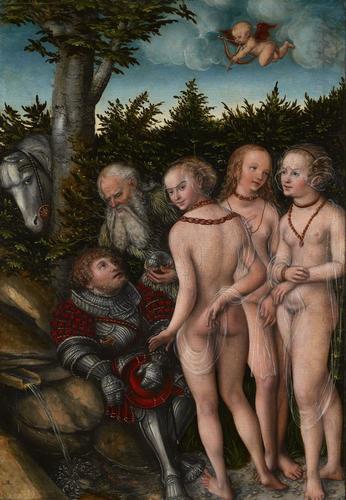-
1 of 253523 objects
The Judgement of Paris c. 1530-35
Oil on panel | 49.7 x 35.1 cm (support, canvas/panel/stretcher external) | RCIN 405757
-
Paris, son of the Trojan King Priam, who was living as a shepherd, was sought out by Mercury, the messenger of the gods, and asked to decide which of the three goddesses, Venus, Juno or Minerva, was the most beautiful. Paris chose Venus, who rewarded him with the beautiful Helen, wife of the Spartan King Menelaus. Paris’s abduction of Helen led to the downfall of Troy. The story told in Dares of Phrygia’s sixth-century Bellum Troianum was modified in later accounts, such as the influential Historia destructionis Troiae by Guido delle Colonne in the thirteenth century. Cranach depicts Paris in armour, slouching with a dazed, sleepy look; in this he follows Guido’s version of the story, where Paris is a knight out hunting who ties his horse to a tree and falls asleep. He dreams that Mercury presented the three goddesses to him and awakes only when he has chosen Venus. Cranach's Mercury is an old man, his golden apple is replaced by a crystal orb inscribed ‘MONET’ (‘it warns’ in Latin), presumably meaning something like 'choose carefully!' The goddesses are hard to identify, but it is probably Venus who stands closest to Paris, casting a knowing look at the viewer and with her left hand in a suggestive position.
The story of Paris was popular at the Saxon court, where Frederick The Wise traced his lineage to the Trojans. The Judgement of Paris was the most represented subject in the palace at Wittenberg and exemplified the ideas of humanists like Conrad Celtis, for whom the story represented a choice between the contemplative, active and sensual life (Minerva's wisdom, Juno's power and Venus's beauty), the ideal being a combination of all three. The goddesses may be hard to differentiate (and seem almost like the Three Graces) because he should be choosing this ideal harmony. The comedy lies in the fact that he obviously isn't: Cupid aims his dart at him and he seems already dazzled by Venus.
As early as 1508 Cranach had produced a large woodcut of the subject, bearing the electoral and ducal arms of Saxony, and he went on to produce at least 12 different versions. This version has been catalogued as a late workshop production after 1537, but the quality is closer to the paintings c.1530-35.Provenance
First recorded without attribution in Queen Caroline's Closet at Kensington Palace in 1743; in a Passage at Kensington in 1818 (no 593) as 'Albert Aldergraef' perhaps meaning Altdorfer; at Hampton Court and recognised as a Cranach by 1860 (no 995)
-
Creator(s)
-
Medium and techniques
Oil on panel
Measurements
49.7 x 35.1 cm (support, canvas/panel/stretcher external)
61.4 x 45.5 x 5.2 cm (frame, external)
Category
Object type(s)
